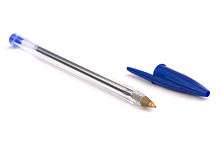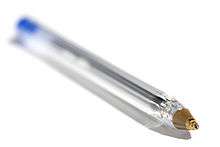Bic Cristal
 | |
| Type |
Ballpoint pen |
|---|---|
| Inventor |
Marcel Bich |
| Inception |
December 1950 |
| Manufacturer |
Société Bic |
| Website |
http://www.bicworld.com/en/our-products/stationery |
The Bic Cristal (stylised as BIC Cristal; also known as the Bic pen) is an inexpensive disposable ballpoint pen mass-produced and sold by Société Bic of Clichy, Hauts-de-Seine, France. It was first launched in December 1950 and is by far the best selling pen in the world – the 100 billionth was sold in September 2006. It has become the archetypal ballpoint pen and is considered ubiquitous,[1] to the extent that the Museum of Modern Art has made it a permanent part of its collection. Its hexagonal form and design mimics a classic lead pencil; it is sold in a variety of colours.
History
In 1944, near the end of the Second World War, entrepreneur Marcel Bich bought a factory in Clichy, a suburb north of Paris,[2] and with business partner Edouard Buffard founded Société PPA (later Société Bic) in 1945. "PPA" stood for Porte-plume, Porte-mines et Accessoires – pens, mechanical pencils and accessories. During the war Bich had seen a ballpoint pen manufactured in Argentina by László Bíró. Between 1949 and 1950 the Bic Cristal was designed by the Décolletage Plastique design team at Société PPA.[3][4] Bich invested in Swiss technology capable of shaping metal down to 0.01 millimetres (0.00039 in), which could produce a stainless steel one-millimetre (0.039 in) sphere which allowed ink to flow freely.[5] Bich developed a viscosity of ink which neither leaked nor clogged and, under a licence purchased from Bíró for the ballpoint, launched the Cristal in December 1950.[3]
Bich invested heavily in advertising, hiring poster designer Raymond Savignac in 1952. That year Bic won the French Oscar de la publicité award for advertising.[2] In 1953 advertising executive Pierre Guichenné advised Bich to shorten his family name to Bic as an easy-to-remember, globally adaptable tradename for the pen, which fit in with product branding trends of the post-war era.[5] Early Bic advertisements in France referred to the Cristal as the "Atomic pen".[6] Throughout the 1950s and 1960s the Bic Cristal's writing tip and ergonomic design helped shift the worldwide market for pens from fountain pens to ballpoints.

In 1959 Bich brought the pen to the American market: the Bic pen was soon selling at 29 cents (equivalent to $2.38 in 2016) with the slogan "writes first time, every time."[7] In 1965 the French ministry of education approved the Bic Cristal for use in classrooms.[8]
In September 2006 the Bic Cristal was declared the best selling pen in the world after the 100 billionth was sold.[9]
Design

The Museum of Modern Art in New York City recognised the Bic Cristal's industrial design by introducing it into the museum's permanent collection.[4][10] Its hexagonal shape resembles the typical wooden pencil and grants strength and three grip points giving high writing stability. The pen's transparent polystyrene barrel and polypropylene tube show the ink-level.[3] A tiny hole in the barrel's body maintains the same air pressure inside and outside the pen.[11] The thick ink flows down due to capillary action from the pressurised tube[8] inside the barrel, to feed the ball bearing, which spins freely within a brass tip.[12] In 1961 the stainless steel ball was replaced with much harder tungsten carbide. This ballpoint is first vitrified by heat, then ground down and milled to an accuracy of 0.1 micrometres (3.9×10−6 in) between spinning plates coated with industrial diamond abrasives.[12] Since 1991 the pen's streamlined polypropylene cap has had a small hole to reduce the risk of suffocation if the cap is inhaled.[3][11] Polypropylene is used instead of polystyrene because it absorbs impact better, reducing the chance of the pen cracking or splitting if it is dropped onto the cap.[12]
The pen's dimensions are 5 7⁄8 by 1⁄2 inch (14.9 cm × 1.3 cm).[10]
The Cristal's design has become a target for counterfeiters, especially from the Far East and in particular from China.[13] Their pens are manufactured at a cheaper price and made to appear similar to the original. One Kenyan pen manufacturer reportedly lost 100,000,000 Kenyan shillings to fake copies, forcing them to negotiate cheaper licensing from Bic.[13]
Spin-offs
Bic Cristal For Her
In 2012 Bic marketed a spin-off product named the "Bic Cristal For Her".[14] The pen, similar to the original, was supposedly designed specifically for women. It was widely mocked on the internet, for instance in the customer reviews section of Amazon.com,[15] and has been included in the collection of the Museum of Failure.[16]
Cristal Stylus
In 2014 Bic released a new writing instrument based on the Cristal, a modified pen with a rubber tip opposite the ballpoint. This model, called the "Cristal Stylus", is for use on touchpads.[17] Bic funded a website to promote the stylus that crowdsourced a new typeface, named the Universal Typeface Experiment.[1]
See also
References
- 1 2 Stamp, Jimmy. "The Universal Typeface Project Averages the World's Handwriting to Produce an Incredibly Average Font". Smithsonian. Retrieved 15 March 2017.
- 1 2 "Our Heritage, Your Passion". BICWorld. Retrieved 1 May 2017.
- 1 2 3 4 Editors of Phaidon (2006). Fletcher, Alan, ed. Phaidon Design Classics – Volume 2 (1. publ. ed.). London: Phaidon Press. ISBN 0-7148-4399-7.
- 1 2 "Humble Masterpieces" (PDF). New York: The Museum of Modern Art. 27 September 2004. Retrieved 13 March 2017.
- 1 2 "Everyday Icon #3 The BIC Biro | Design | Agenda | Phaidon". Phaidon. Retrieved 16 May 2017.
- ↑ Rota, Matt. The Art of Ballpoint: Experimentation, Exploration, and Techniques in Ink. Rockport Publishers. p. 12. ISBN 978-1-63159-057-3. Retrieved 26 March 2017.
An early BIC ad campaign referred to the pen as the 'Atomic Pen.'
- ↑ Larcen, Donna (4 July 1995). "Who Says $1 Dollar Won't Buy Anything Anymore". The Hartford Courant. Retrieved 30 June 2014.
- 1 2 Smith, David (14 June 2008). "It's 70 today, but our favourite pen just keeps rolling along". The Guardian.
- ↑ "Pen – best selling". Guinness World Records. 9 January 2006. Retrieved 13 February 2016.
- 1 2 "Bic Cristal in MoMA collection". Moma.org. Retrieved 4 August 2013.
- 1 2 "FAQ – BIC AU Website". au.bicworld.com. Retrieved 1 May 2017.
- 1 2 3 Lemon, Michael (28 April 2015). "Bic Cristal Pens | The World's Most Popular Pen". OSU.EDU. Ohio State University. Retrieved 26 March 2017.
- 1 2 Waka, Brenda. "RESPONSE STRATEGIES OF HACO INDUSTRIES KENYA LIMITED TO THE CHALLENGES OF COUNTERFEIT PRODUCTS IN EAST AFRICA" (PDF). University of Nairobi Digital Repository. Haco Industries Kenya Limited. Retrieved 21 April 2017.
- ↑ Vinjamuri, David. "Bic For Her: What They Were Actually Thinking (As Told By A Man Who Worked On Tampons)". Forbes. Retrieved 17 April 2017.
- ↑ News, ABC. "Bic Pens 'For Her' Draw Amazon Flames". ABC News. Retrieved 17 April 2017.
- ↑ Hauser, Christine; Anderson, Christina (April 21, 2017). "At This Museum, Failures Are Welcome". New York Times.
- ↑ Liszewski, Andrew (28 January 2014). "The Classic Bic Pen Now Works On Your Smartphone Display Too". Gizmodo. Retrieved 17 March 2017.
External links
- Official website of the Bic Cristal at Société BIC
- Bic Cristal at MoMA
- Everyday Icon #3 The BIC Biro at Phaidon Press online
- EAN 3086123001060